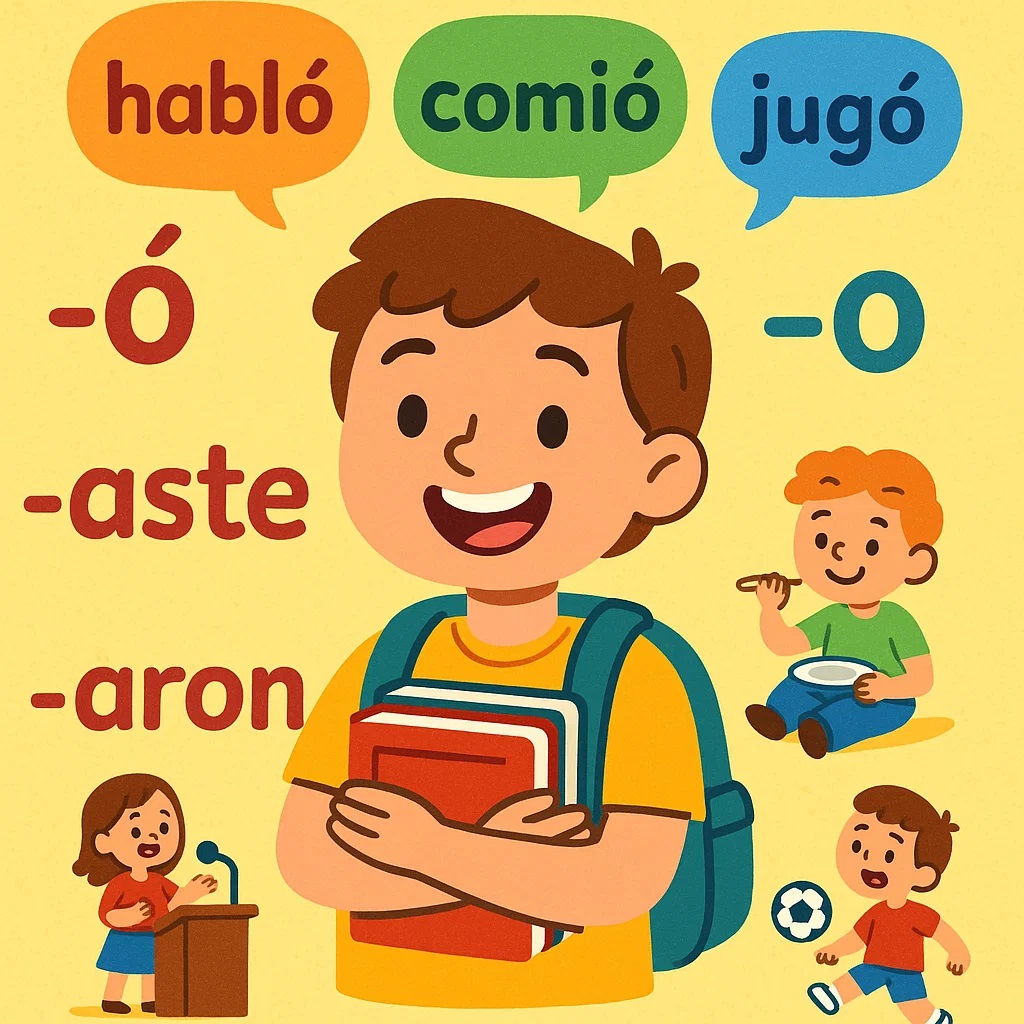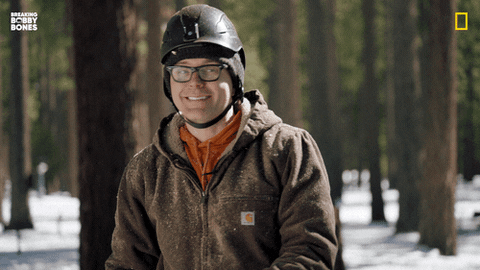Article created on June 10, 2025, article updated on June 11, 2025, by Sandra Sánchez

Content:
- What is the Spanish Preterite Tense?
- When to Use the Preterite Tense
- How to Form the Preterite Tense
- Common Irregular Preterite Verbs
- The i-Group Irregular Verbs
- Effective Learning Strategies for the Preterite Tense
- Common Challenges and How to Overcome Them
- Case Study: Mark’s Journey to Preterite Mastery
- Practical Exercises to Reinforce Your Learning
- Preterite vs. Imperfect: Understanding the Distinction
- Your Preterite Mastery Roadmap
- Frequently Asked Questions
What is the Spanish Preterite Tense?
The preterite tense (el pretérito indefinido) is one of the two main past tenses in Spanish. Unlike the imperfect tense, which describes ongoing or habitual past actions, the preterite expresses completed actions that occurred at a specific point in time.
Think of the preterite as the “snapshot” tense—it captures moments that started and finished in the past:
- Ayer caminé al parque. (Yesterday I walked to the park.)
- Ellos comieron a las dos. (They ate at two o’clock.)
- Cristina escribió una carta. (Cristina wrote a letter.)
When to Use the Preterite Tense
Before diving into conjugations, let’s understand when to use the preterite tense. This understanding will make memorizing the forms more meaningful and practical.
Completed Actions in the Past
The primary use of the preterite is for actions that both began and ended in the past:
- Viajé a México el año pasado. (I traveled to Mexico last year.)
- Ella estudió durante cinco horas. (She studied for five hours.)
Interrupted Actions
Use the preterite for actions that were interrupted by another action:
- Dormía cuando sonó el teléfono. (I was sleeping when the phone rang.)
With Certain Time Expressions
The preterite often appears with specific time expressions that indicate completed periods:
- ayer (yesterday)
- anoche (last night)
- la semana pasada (last week)
- el mes pasado (last month)
- en 2010 (in 2010)
- una vez (one time)

How to Form the Preterite Tense
Now that we understand when to use it, let’s explore how to form the preterite tense for regular verbs.
Regular -AR Verbs
To conjugate regular -AR verbs in the preterite, remove the -AR ending and add these endings:
| Subject Pronoun | Ending | Example: Hablar (to speak) |
|---|---|---|
| yo | -é | hablé |
| tú | -aste | hablaste |
| él/ella/usted | -ó | habló |
| nosotros/nosotras | -amos | hablamos |
| vosotros/vosotras | -asteis | hablasteis |
| ellos/ellas/ustedes | -aron | hablaron |
Notice the accent marks on the first and third person singular forms. These are crucial for correct pronunciation and writing!
Regular -ER and -IR Verbs
For regular -ER and -IR verbs, remove the ending and add these:
| Subject Pronoun | Ending | Example: Comer (to eat) | Example: Vivir (to live) |
|---|---|---|---|
| yo | -í | comí | viví |
| tú | -iste | comiste | viviste |
| él/ella/usted | -ió | comió | vivió |
| nosotros/nosotras | -imos | comimos | vivimos |
| vosotros/vosotras | -isteis | comisteis | vivisteis |
| ellos/ellas/ustedes | -ieron | comieron | vivieron |
Common Irregular Preterite Verbs
Here’s where things get tricky. Many common Spanish verbs have irregular preterite forms. Rather than getting overwhelmed, focus on learning the most frequently used ones first.
Some irregular verbs follow predictable patterns. Let’s explore them:
Stem-Changing Irregulars
These verbs completely change their stems in the preterite:
| Infinitive | Stem Change | Example (yo form) |
|---|---|---|
| ser/ir (to be/to go) | fu- | fui |
| hacer (to do/make) | hic-/hiz- | hice |
| estar (to be) | estuv- | estuve |
| tener (to have) | tuv- | tuve |
| poder (to be able to) | pud- | pude |
An interesting fact: “ser” (to be) and “ir” (to go) have identical conjugations in the preterite tense! Context will help you determine which meaning is intended.
Visualization: Most Common Irregular Verbs Usage
85%
70%
65%
55%
45%
Frequency of appearance in everyday Spanish conversation (approximate percentages)
Verbs with Spelling Changes
Some verbs undergo spelling changes in the preterite to maintain pronunciation. For example:
- Verbs ending in -car change c → qu in the yo form: buscar → busqué (I looked for)
- Verbs ending in -gar change g → gu in the yo form: llegar → llegué (I arrived)
- Verbs ending in -zar change z → c in the yo form: empezar → empecé (I began)

The i-Group Irregular Verbs
A special group of irregular verbs in the preterite follows a pattern known as the “i-group.” These verbs share similar conjugation patterns:
- preferir (to prefer)
- sentir (to feel)
- pedir (to ask for)
- servir (to serve)
- repetir (to repeat)
They all change their stem vowel to “i” and follow this pattern:
Example with “sentir” (to feel):
- yo sentí
- tú sentiste
- él/ella/usted sintió
- nosotros sentimos
- vosotros sentisteis
- ellos/ellas/ustedes sintieron
Notice the stem change in the third person singular and plural forms.
Effective Learning Strategies for the Preterite Tense
Now that we understand the mechanics, let’s explore proven strategies to master the preterite tense:
Strategy 1: Group Verbs by Patterns
Instead of memorizing verbs alphabetically, group them by their conjugation patterns. This helps your brain recognize patterns rather than isolated facts.
For example, group all -car, -gar, and -zar verbs together, since they all have spelling changes in the yo form.
Strategy 2: Use Spaced Repetition
Research shows that reviewing information at increasing intervals helps transfer it to long-term memory. Apps like Anki or Quizlet can help you create flashcards with preterite forms and set up spaced repetition schedules.
María, a Spanish learner from Boston, shares: “I struggled with irregular preterites until I started using spaced repetition. I created flashcards for five verbs daily and reviewed them according to a schedule. Within a month, I could confidently use most common irregular preterites in conversation.”
Strategy 3: Learn Through Story-Telling
Create or follow simple stories that use many preterite verbs. For example:
Ayer fui (ir) al supermercado. Compré (comprar) fruta y pan. Conocí (conocer) a un vecino nuevo y hablamos (hablar) por diez minutos. Después, volví (volver) a casa y preparé (preparar) la cena.
(Yesterday I went to the supermarket. I bought fruit and bread. I met a new neighbor and we talked for ten minutes. Afterward, I returned home and prepared dinner.)
Strategy 4: Practice with Time Expressions
Associate preterite verbs with common time expressions that trigger this tense:
- ayer (yesterday)
- la semana pasada (last week)
- el mes pasado (last month)
- el año pasado (last year)
- anoche (last night)
- una vez (one time)
Practice making sentences using these expressions with different verbs in the preterite.

Common Challenges and How to Overcome Them
When learning the preterite tense, students typically face several hurdles. Let’s address them head-on:
Challenge 1: Irregular Verb Overload
Problem: The sheer number of irregular verbs feels overwhelming.
Solution: Focus on frequency. Start with the most common irregular verbs (ser/ir, estar, tener, hacer, poder) and master those before moving on. According to a corpus analysis, these five verbs account for approximately 70% of irregular preterite usage in everyday conversation.
Challenge 2: Confusing Ser and Ir
Problem: Since “ser” and “ir” have identical conjugations in the preterite, it can be confusing to know which meaning is intended.
Solution: Pay attention to context clues. “Ser” (to be) typically describes characteristics or identities in the past, while “ir” (to go) involves movement or travel. Practice with sentences that clearly differentiate the two:
- El concierto fue increíble. (The concert was incredible.) – ser
- Ellos fueron al concierto. (They went to the concert.) – ir
Challenge 3: Accents and Spelling Changes
Problem: Forgetting accent marks or spelling changes can change meaning or sound incorrect.
Solution: Create mnemonic devices or visual cues. For example, draw the accent marks larger when writing practice conjugations, or use color-coding for spelling changes.
Case Study: Mark’s Journey to Preterite Mastery
Mark, an English teacher learning Spanish for a trip to Argentina, struggled with the preterite tense. “I could memorize the conjugations for a quiz, but when trying to speak about past events, my mind would go blank,” he explains.
His breakthrough came when he implemented these strategies:
- Daily journaling in Spanish about his previous day, forcing active recall of preterite forms
- Creating memory palaces where he visualized irregular verbs in specific locations in his house
- Recording himself telling short stories in the past tense and listening back
- Finding a language exchange partner specifically to practice past tense narratives
“After six weeks of focused practice, I could tell stories about my past experiences without constantly pausing to remember conjugations. When I finally visited Argentina, locals commented on how naturally I used the past tense,” Mark reports.
Practical Exercises to Reinforce Your Learning
Here are some exercises to help cement your understanding of the preterite tense:
Exercise 1: Regular Verb Transformation
Transform these sentences from present to preterite:
- Yo hablo con mi madre. → _______
- Tú comes pasta. → _______
- María escribe un libro. → _______
- Nosotros vivimos en Madrid. → _______
- Ellos trabajan mucho. → _______
Exercise 2: Irregular Verb Challenge
Fill in the blanks with the correct irregular preterite form:
- Yo _______ (hacer) la tarea ayer.
- Nosotros _______ (tener) un perro cuando éramos niños.
- Tú _______ (estar) en la fiesta, ¿verdad?
- Ellos _______ (ir) al cine el sábado pasado.
- Ella no _______ (poder) terminar el proyecto a tiempo.
Exercise 3: Storytelling
Create a short story using at least 8 different verbs in the preterite tense. Include both regular and irregular verbs. Begin with: “El sábado pasado…”

Preterite vs. Imperfect: Understanding the Distinction
While this guide focuses on the preterite, it’s worth briefly addressing the other main past tense in Spanish—the imperfect. Understanding when to use each is crucial for mastering past narration in Spanish.
| Preterite (Pretérito) | Imperfect (Imperfecto) |
|---|---|
| Completed actions with clear start/end | Ongoing or habitual actions |
| Specific, defined moments | Background information, setting the scene |
| Sequential events in a story | Descriptions of how things were |
| Changes or interruptions | Continuing situations |
| Ayer comí en un restaurante. | De niño comía muchas verduras. |
A helpful analogy: If you think of past narration as a movie, the preterite forms the “action shots” that move the plot forward, while the imperfect provides the “background scenery” that sets the context.
Your Preterite Mastery Roadmap
Rather than offering a generic conclusion, let’s create a clear pathway for your preterite learning journey:
- Week 1: Regular Foundations
- Master regular -AR verbs in the preterite
- Practice with 10 common regular -AR verbs daily
- Focus on correct pronunciation and accent placement
- Week 2: Expand Your Range
- Add regular -ER and -IR verbs to your practice
- Begin working with time expressions that trigger preterite use
- Start a daily “preterite journal” with 3-5 sentences about your day
- Week 3: Tackle Top Irregulars
- Focus on the “Big Five” irregular verbs: ser/ir, estar, tener, hacer, poder
- Practice distinguishing between ser and ir in context
- Incorporate these irregulars into your daily journal
- Week 4: Spelling Changes & Special Groups
- Master -car, -gar, and -zar verbs and their spelling changes
- Learn the i-group verbs and their patterns
- Begin creating short stories using mixed regular and irregular verbs
- Week 5: Integration & Fluency Building
- Practice distinguishing between preterite and imperfect in narratives
- Seek out natural language exposure through Spanish films, podcasts, or conversations
- Record yourself telling a complete story in the past tense
Remember, language learning isn’t about perfect memorization—it’s about practical communication. As you progress through this roadmap, focus on conveying meaning rather than achieving grammatical perfection. With consistent practice, the preterite forms will become second nature.
How would your Spanish fluency transform if you could effortlessly tell stories about past events? Start your preterite mastery journey today, and watch as new worlds of expression open before you.

Frequently Asked Questions
How do I know when to use the preterite versus the imperfect tense?
Use the preterite for completed actions with clear beginning and end points, specific moments in time, and actions that interrupt ongoing situations. Use the imperfect for habitual or repeated actions in the past, ongoing situations without emphasizing completion, and for setting the scene or providing background information. A helpful tip: if you can answer “When did it happen?” with a specific time, it’s likely preterite. If you’re describing “how things were” or “what used to happen,” it’s typically imperfect.
What’s the best way to memorize irregular preterite verbs?
Rather than trying to memorize all irregular verbs at once, focus on frequency and patterns. Start with the most common irregulars (ser/ir, estar, tener, hacer, poder) and practice them in context through sentences and stories. Group verbs with similar patterns (like the i-group verbs) and learn them together. Spaced repetition techniques are very effective—review the forms repeatedly over increasing intervals. Finally, use mnemonic devices or mental associations to help remember particularly challenging forms.
How can I practice the preterite tense in real-life situations?
Create opportunities to talk about past events in Spanish. Start a daily journal where you write 3-5 sentences about what you did yesterday. Find a language exchange partner and take turns telling stories about your weekend or childhood. Watch Spanish movies or TV shows and pay attention to when characters use the preterite. Practice narrating past events out loud, even if just to yourself. When reading Spanish texts, highlight preterite verbs and note how they’re used in context. The key is consistent, meaningful practice that connects the grammatical forms to real communication needs.
Need a Personal Spanish Teacher?
Looking for a more personalized approach to mastering Spanish? Sandra Sanchez, the passionate and experienced teacher behind Spanish Barcelona, offers one-on-one and group lessons tailored to your needs and goals.
Whether you’re a beginner or looking to refine your skills, Sandra’s customized lessons will help you gain confidence and fluency in no time.
📌 Ready to get started? Leave your request today, and let’s make Spanish learning fun and effective for you!
